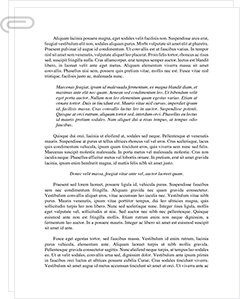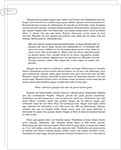 Study Document
Study Document
Using Health Behavior Models to Address Obesity Among School Children The Health Belief Model Term Paper
Pages:10 (2937 words)
Sources:7
Document Type:Term Paper
Document:#65300503
HEALTH BELIEF MODEL APPLICATIONUsing Health Behavior Models to Address Obesity among School ChildrenIntroductionThe number of overweight school children has significantly increased over the last few decades. Data from the Centers for Disease Control and Prevention CDC (2021) indicates that approximately 13 million school children in the U.S. could be deemed obese. This essentially means that the prevalence of obesity at present among this age group happens to stand at 18.5% (CDC, 2021). To a large extent, this is a clear indication that something needs to be done urgently to salvage the situation. This is more so the case given that according to the CDC (2021), obesity puts children at significant risk of poor health. Obesity could also result in various other issues revolving around mental health and wellbeing. This is more so the case given that as Jelalian and Steele (2008) point out, overweight children are more likely to be teased by their peers or to develop low self-esteem or body image problems (p. 311). Further, there is evidence indicating that overweight and obesity in childhood is likely to be carried on to adulthood.In adulthood, obesity has been closely linked to several leading causes of death (Kirch, 2008). These are inclusive of, but they are not limited to; certain kinds of cancer, stroke, heart disease, as well as diabetes. It therefore follows that we have all the motivation to implement strategies to reduce obesity rates across the nation. It would be prudent to note that according to Kirch (2008), studies have in the past linked obesity to a wide range of factors including, but not limited to; lack of physical activity and poor food choices (i.e. consumption of high simple carbohydrate diets). As the author further points out, genetics have also been shown to play a role effectively meaning that a child or individual whose parents are obese is also likely to be obese. All these factors should be taken into consideration in efforts to address obesity among school children.There are a wide range of theories that could be applied in the development of a program that aims to reign in obesity amongst school children. Models which could be taken into consideration are inclusive of, but they are not limited to; the health belief model, the transtheoretical model, the social ecological model, and the social cognitive theory. This indicates that to a large extent, there is no standard model routinely applied or deployed in behavioral change as well as health education and promotion efforts. In the present exercise, the health belief model will be taken into consideration in efforts to address obesity among school children.The Health Belief ModelThis particular model, according to Glanz, Rimer, and Viswanath (2015), happens to be one of the most utilized models in efforts to not only comprehend, but also understand health behaviors. Indeed, it has been defined by the authors as one of the most widely recognized conceptual frameworks for creating healthy behaviors by focusing on positive behavioral change at the individual level (Glanz, Rimer, and Viswanath, 2015, p. 211). For this reason, I am convinced that this particular model would come in handy in enabling us to better comprehend and chart the most viable intervention measures to be implemented on this front. In the present setting, the model will be used to promote education and awareness programs at school aimed at motivating school children to embrace better eating habits and participate in physical activities (i.e. by joining an athletics club). More specifically, the education and awareness program will be firmly rooted on the HBM model and will be focused on bringing about…
…for some families.ConclusionIn the final analysis, it is important to note that in the present undertaking, efforts were made to increase perceived susceptibility to obesity. This was necessary owing to the fact that, as it has been pointed out in the introductory section of this text, obesity amongst school children happens to be one of the most significant health concerns today. As a matter of fact, as it has been pointed out, approximately 13 million school children in the U.S. could be deemed obese. This is an indication that a significant percentage of our school children are obese. It should be noted that the estimate is not inclusive of the number of school children who are deemed or considered overweight.In the present undertaking, the perceived seriousness of obesity was also highlighted. This was done so as to ensure that school children have a basis upon which to anchor their desire to maintain an ideal body weight. If the said school children do not consider the consequences of obesity to be serious enough, they are not likely to embrace the two courses of action discussed, i.e. i.e. adoption of a healthy diet and engagement in physical activities.Third, efforts were made to decrease the barriers likely to be perceived while at the same time increasing the benefits that were perceived by the school children. Thus, if the school children were to conduct a cost-benefit analysis, they would be in favor of embracing the two courses of action suggested so as to maintain the ideal body weight and, thus, avoid obesity. Lastly, it may also be necessary to point out that the need to avail cues to action was taken into consideration. This was necessary so as to ensure that school children were not only encouraged, but also reminded of the need to pursue…
Related Documents
 Study Document
Study Document
Health Promotion in the Area
Christodolous et al. (2006) find that "children who reported less than 30 minutes of daily participation in physical activity demonstrated lower prevalence rates for overweight and obesity as well as superior fitness performance. The detrimental effect of the summer break on the progress of physical fitness was less in children who did participate in physical activity than in those who did not." (Christodolous et al., 199) This helps to
 Study Document
Study Document
Health Maintenance Organization Impact on
" (AAFP, nd) The Health Maintenance Organization further should "…negotiate with both public and private payers for adequate reimbursement or direct payment to cover the expenses of interpreter services so that they can establish services without burdening physicians…" and the private industry should be "…engaged by medical organizations, including the AAFP, and patient advocacy groups to consider innovative ways to provide interpreter services to both employees and the medically underserved." (AAFP,
 Study Document
Study Document
School-Based Intervention Trials for the
, 1999). In many areas of the country this may be very accurate. Another problem that comes into the picture where obesity in children is concerned is that many parents must work very long hours today to pay bills and have money for what their family needs (Mokdad, et al., 1999). Because of this, many children are latchkey kids and are not watched as closely by their parents as they used
 Study Document
Study Document
Childhood Obesity Prevention in Mexican American School Age Children...
Childhood Obesity One of the most significant health problems seen in the United States is obesity. Within this dynamic there are particular issues of special concern for the health care industry and society in general, most notably the exponential increase in obesity found among children. (Strauss, Pollack, 2001, pgs. 2845-2848) and (Troiano, Flegel, 1998, pgs. 497-504) "Childhood obesity has more than doubled over the past 20 years, and it represents the
 Study Document
Study Document
Childhood Obesity Epidemic Terms Defined
" (Dietz, 1998). Obese children are often taller than their non-overweight peers, and are apt to be viewed as more mature. This is an inappropriate expectation that may result in adverse effects on their socialization. (Dietz, 1998). Overweight children and adolescents report negative assumptions made about them by others, including being inactive or lazy, being strong or tougher than others, not having feelings and being unclean. (American Obesity Association, 2000). This
 Study Document
Study Document
Developing Obesity Program
Obesity Prevention Program: Project Planning Stakeholder identification Childhood obesity-prevention demonstration projects The ANGELO process Socio-cultural contextual analyses Stakeholder engagement Engagement workshops Action plan formulation The Budget Financial Analysis Evaluation methods The Trans-theoretical model The evaluation plan Economic evaluation Obesity prevention is best carried out through community-based arrangements. This paper provides a guide on the setting of priorities, with regard to the prevention of childhood obesity among the culturally and socially diverse populations of Pinole, Laurel Park and Marina Bay. The literature offers a report




